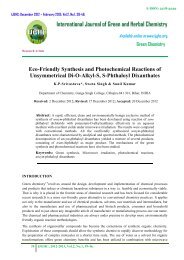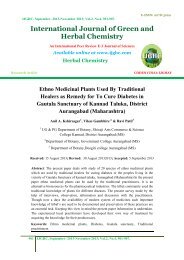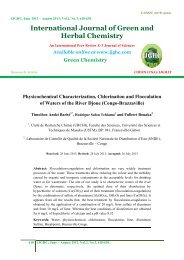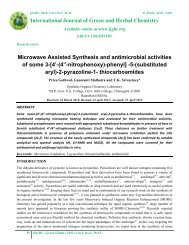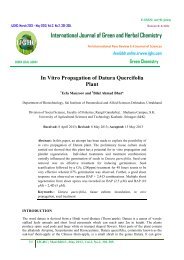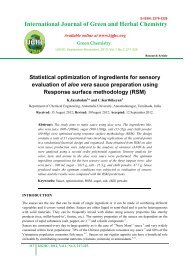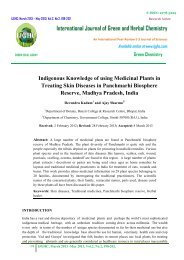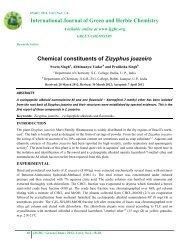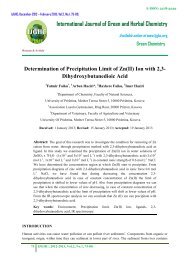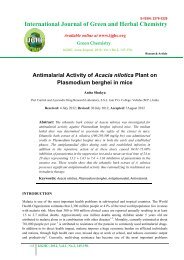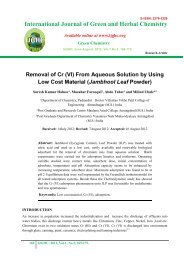Iron Fractionation in the Sediments of Kerala Coast - IJGHC
Iron Fractionation in the Sediments of Kerala Coast - IJGHC
Iron Fractionation in the Sediments of Kerala Coast - IJGHC
You also want an ePaper? Increase the reach of your titles
YUMPU automatically turns print PDFs into web optimized ePapers that Google loves.
<strong>IJGHC</strong>, June 2013 – August 2013; Vol.2, No.3; 555-561.<br />
International Journal <strong>of</strong> Green and<br />
Herbal Chemistry<br />
An International Peer Review E-3 Journal <strong>of</strong> Sciences<br />
Available onl<strong>in</strong>e at www.ijghc.com<br />
Green Chemistry<br />
E-ISSN: 2278-3229<br />
Research Article<br />
CODEN (USA): IJGHAY<br />
<strong>Iron</strong> <strong>Fractionation</strong> <strong>in</strong> <strong>the</strong> <strong>Sediments</strong> <strong>of</strong> <strong>Kerala</strong> <strong>Coast</strong><br />
Manju P. Nair and Sujatha C. H*.<br />
Department <strong>of</strong> Chemical Oceanography, School <strong>of</strong> Mar<strong>in</strong>e Sciences,<br />
Coch<strong>in</strong> University <strong>of</strong> Science and Technology, Kochi-16, <strong>Kerala</strong>, India<br />
Received: 20 May 2013; Revised: 12 June 2013; Accepted: 24 June 2013<br />
Abstract: This study gives <strong>the</strong> first report on <strong>the</strong> spatial changes <strong>of</strong> different iron<br />
fractions <strong>in</strong> <strong>the</strong> sediments <strong>of</strong> <strong>Kerala</strong> <strong>Coast</strong>. <strong>Sediments</strong> were collected from four<br />
prom<strong>in</strong>ent areas <strong>of</strong> <strong>Kerala</strong> <strong>Coast</strong>. A sequential extraction procedure was applied to<br />
identify <strong>the</strong> forms <strong>of</strong> Fe. This scheme extracts different chemical forms <strong>of</strong> metals <strong>in</strong><br />
five sequential steps, namely- exchangeable (EXC), carbonate –bound (CA), Fe-Mn<br />
oxide– bound (FMO), organic matter–bound (OM), and residual (RES) fractions <strong>of</strong><br />
metals. Most content <strong>of</strong> Fe was found <strong>in</strong> residual fraction <strong>in</strong> all designated sites.<br />
Comparatively Coch<strong>in</strong> revealed to be more viable for secondary pollution due to high<br />
content <strong>of</strong> EXC and CA. FMO fraction recorded <strong>in</strong> <strong>the</strong> sampl<strong>in</strong>g site was rich at<br />
Coch<strong>in</strong> and poor at Trivandrum. This exposes <strong>the</strong> greater scavench<strong>in</strong>g ability <strong>of</strong><br />
hydrous iron oxide from <strong>the</strong> water column. OM fractions are <strong>the</strong> second largest key<br />
scavenger for <strong>the</strong> heavy metals was high at Coch<strong>in</strong> and low at Trivandrum. Pr<strong>in</strong>cipal<br />
component analysis and correlation analysis were done to understand <strong>the</strong><br />
<strong>in</strong>terrelationship between <strong>the</strong> parameters. Pr<strong>in</strong>cipal component analysis showed two<br />
components govern <strong>the</strong> distribution <strong>of</strong> Fe fraction <strong>in</strong> <strong>the</strong> study area. Correlation<br />
analysis revealed except residual fraction all <strong>the</strong> o<strong>the</strong>r fraction were directly related<br />
to TOC, mud content, total phosphorus, total nitrogen and total hydrogen.<br />
Keywords: <strong>Fractionation</strong>, <strong>Iron</strong>, Sediment, <strong>Kerala</strong> <strong>Coast</strong>, Coch<strong>in</strong>.<br />
555 <strong>IJGHC</strong>; June – August 2013, Vol.2, No.3, 555-561.
<strong>Iron</strong>….<br />
Nair and Sujatha.<br />
INTRODUCTION<br />
Heavy metal pollution <strong>of</strong> coastal environments has been reported throughout <strong>the</strong> region <strong>of</strong> <strong>the</strong> world.<br />
Release <strong>of</strong> heavy metals to <strong>the</strong> mar<strong>in</strong>e environment is <strong>in</strong>creas<strong>in</strong>g as <strong>in</strong>dustrial development cont<strong>in</strong>ues<br />
<strong>in</strong> areas where monitor<strong>in</strong>g and enforcement <strong>of</strong> environmental regulations is difficult due to a lack <strong>of</strong><br />
laboratory facilities and enforcement mechanisms. Heavy metals, <strong>in</strong> contrast with most pollutants, are<br />
not biodegradable and undergo a global ecobiological cycle <strong>in</strong> which natural waters are <strong>the</strong> ma<strong>in</strong><br />
pathways 1 . Once heavy metals are discharged <strong>in</strong>to coastal waters, <strong>the</strong>y rapidly become associated with<br />
particulates and are <strong>in</strong>corporated <strong>in</strong> bottom sediments.<br />
The accumulation <strong>of</strong> metals from <strong>the</strong> overly<strong>in</strong>g water <strong>the</strong>n to sediment is dependent on a number <strong>of</strong><br />
external environmental factors such as pH, Eh, ionic strength, anthropogenic <strong>in</strong>put, <strong>the</strong> type and<br />
concentration <strong>of</strong> organic and <strong>in</strong>organic ligands and <strong>the</strong> available surface area for adsorption caused by<br />
<strong>the</strong> variation <strong>in</strong> gra<strong>in</strong> size distribution 2 . Various remobilization mechanisms <strong>of</strong> bed sediments<br />
<strong>in</strong>clud<strong>in</strong>g physical resuspension 3 , geochemical remobilization from organic matter , dissolution <strong>of</strong><br />
hydrous oxides <strong>of</strong> iron and manganese biomethylation 4,5 , and o<strong>the</strong>r biological processes can cause<br />
release <strong>of</strong> <strong>the</strong>se elements to <strong>the</strong> water column. Additionally, <strong>the</strong>se categories have different behaviors<br />
with respect to remobilization under chang<strong>in</strong>g environmental conditions 6 . Studies <strong>of</strong> <strong>the</strong> trace metal<br />
contam<strong>in</strong>ation <strong>of</strong> sediments <strong>of</strong>ten rely on <strong>the</strong> analysis <strong>of</strong> total metal content; however, <strong>in</strong>formation on<br />
total concentration is not sufficient for understand<strong>in</strong>g <strong>the</strong> environmental behaviour <strong>of</strong> trace metals, as<br />
only a fraction <strong>of</strong> <strong>the</strong> total metal is available for biological or diagenetic processes. Assessment <strong>of</strong><br />
heavy metal contam<strong>in</strong>ation <strong>of</strong> <strong>the</strong> coastal environment based solely on total metal content also<br />
possesses difficult problems to regulators; how to dist<strong>in</strong>guish between background lithogenic trace<br />
metal that is relatively unavailable to mar<strong>in</strong>e biota and <strong>the</strong> accessible labile trace metal.<br />
The aqueous chemistry <strong>of</strong> iron and its role <strong>in</strong> controll<strong>in</strong>g <strong>the</strong> release and availability <strong>of</strong> sedimentassociated<br />
contam<strong>in</strong>ants is <strong>of</strong> major concern. <strong>Iron</strong> can exist <strong>in</strong> aquatic systems (natural waters and<br />
<strong>the</strong>ir sediments) <strong>in</strong> several oxidation states: metallic iron (iron metal), ferrous iron (Fe II), and ferric<br />
iron (Fe III). The occurrence <strong>of</strong> elevated levels <strong>of</strong> trace metals especially <strong>in</strong> <strong>the</strong> sediments can be a<br />
good <strong>in</strong>dicator <strong>of</strong> man-<strong>in</strong>duced pollution and high levels <strong>of</strong> heavy metals can <strong>of</strong>ten be attributed to<br />
anthropogenic <strong>in</strong>fluences, ra<strong>the</strong>r than natural enrichment <strong>of</strong> <strong>the</strong> sediment by geological wea<strong>the</strong>r<strong>in</strong>g 2 .<br />
The objective <strong>of</strong> <strong>the</strong> present study was to estimate <strong>the</strong> amount and variation pattern <strong>of</strong> Fe <strong>in</strong> <strong>the</strong><br />
sediments <strong>of</strong> <strong>Kerala</strong> <strong>Coast</strong> us<strong>in</strong>g a sequential extraction procedure.<br />
MATERIALS AND METHODS<br />
Sediment samples were collected <strong>in</strong> cruise no. 267 <strong>in</strong> FORV Sagar Sampada on May to June 2009<br />
from Tuticor<strong>in</strong> to Coch<strong>in</strong>. <strong>Sediments</strong> were collected from four identified stations [Cape (1),<br />
Trivandrum (2), Kollam (2) and Coch<strong>in</strong> (2)] <strong>of</strong> <strong>Kerala</strong> coast, India. The description <strong>of</strong> location<br />
sites are given <strong>in</strong> Table-1. Surficial sediment samples were collected us<strong>in</strong>g a Van veen grab, it<br />
was sealed, transported to <strong>the</strong> lab and stored <strong>in</strong> deep freezer. <strong>Sediments</strong> were air dried, f<strong>in</strong>ely<br />
powdered and used for chemical analysis.<br />
For metal analysis, 0.5g samples were treated with 5:1 mixture <strong>of</strong> concentrated 7 HNO 3 and HClO 4 .<br />
<strong>Iron</strong> fractionation <strong>of</strong> sediment portions was performed <strong>in</strong> replicates by sequential extraction with<br />
chelat<strong>in</strong>g compounds 8 . Textural characteristics (sand, silt, and clay) were determ<strong>in</strong>ed us<strong>in</strong>g pipette<br />
analysis by Lewis 9 . TOC was determ<strong>in</strong>ed by total organic carbon (TOC) analyzer (Elementar Vario<br />
Select, Germany). Elemental compositions - CHN <strong>of</strong> <strong>the</strong> samples were determ<strong>in</strong>ed by us<strong>in</strong>g Vario EL<br />
111 CHN Analyser. Total phosphorus was estimated by us<strong>in</strong>g <strong>the</strong> standard method. All <strong>the</strong> samples,<br />
556 <strong>IJGHC</strong>; June – August 2013, Vol.2, No.3, 555-561.
<strong>Iron</strong>….<br />
Nair and Sujatha.<br />
chemical solutions, and standards were prepared us<strong>in</strong>g ultrapure water. Statistical analysis was<br />
performed by Statistical Package for Social Sciences (SPSS Version: 11; SPSS Inc. 1995).<br />
Table-1: Location <strong>of</strong> sampl<strong>in</strong>g sites<br />
Transect Depth(m) Location<br />
Cape1 (P 1 ) 50 0747.64 0 N,7730.177 0 E<br />
Trivandrum1(P 2 ) 30 0830.048 0 N,7650.874 0 E<br />
Trivandrum 2 (P 3 ) 100 0828.117 0 N,7629.712 0 E<br />
Kollam1 (P 4 ) 50 099.010 0 N,0756.851 0 E<br />
Kollam2 (P 5 ) 200 0900.084 0 N,07623.524 0 E<br />
Coch<strong>in</strong>1 (P 6 ) 30%) and silt (>40%) content were greater <strong>in</strong> Coch<strong>in</strong>. Among <strong>the</strong> eleven<br />
stations <strong>the</strong> percentage <strong>of</strong> sand fraction was highest <strong>in</strong> Trivandrum (99.3%) and lowest <strong>in</strong><br />
Coch<strong>in</strong> (11.9%). Clay was highest <strong>in</strong> Coch<strong>in</strong> (33.171%) and lowest <strong>in</strong> Trivandrum (0.203%). Silt was<br />
maximum <strong>in</strong> Coch<strong>in</strong> (42.748%) and m<strong>in</strong>imum <strong>in</strong> Kollam (0.132%). Gra<strong>in</strong> size is one <strong>of</strong> <strong>the</strong> basic<br />
attributes <strong>of</strong> sediments and its distribution is essential to del<strong>in</strong>eate <strong>the</strong> sedimentary environments. PH<br />
<strong>in</strong> <strong>the</strong> sediment varied between 7.1 to 8.9, revealed <strong>the</strong> alkal<strong>in</strong>e nature <strong>of</strong> <strong>the</strong> sediment. TOC <strong>in</strong> <strong>the</strong><br />
557 <strong>IJGHC</strong>; June – August 2013, Vol.2, No.3, 555-561.
<strong>Iron</strong>….<br />
Nair and Sujatha.<br />
sediment varied between 0.47 to 5.98%. TOC value < 5% <strong>in</strong>dicate <strong>the</strong> unpolluted sites. In present<br />
study except one site <strong>in</strong> Coch<strong>in</strong> (P6) all o<strong>the</strong>rs revealed to be hav<strong>in</strong>g less polluted. Elemental<br />
distribution showed <strong>the</strong> order as C > P > H > N <strong>in</strong> all <strong>the</strong> stations.<br />
Total metal content distribution <strong>in</strong> <strong>the</strong> study area is given <strong>in</strong> Fig.1. The variation showed as Fe > Mn<br />
> Zn > Cu> Pb > Co > Cd at Cape, Trivandrum and Kollam but at Coch<strong>in</strong> it gives <strong>the</strong> trend as Fe ><br />
Zn> Mn > Cu > Pb> Co > Cd. High concentration <strong>of</strong> all <strong>the</strong> metals <strong>in</strong> <strong>the</strong> present study reported at<br />
Coch<strong>in</strong> due to <strong>the</strong> heavy <strong>in</strong>dustrial, domestic and agricultural discharges. These sediments conta<strong>in</strong>s<br />
greater mud content also help <strong>the</strong>m to adsorb <strong>the</strong>se metals tightly. Metal distribution showed greater<br />
content Fe .So fractionation <strong>of</strong> this particular metal carried out.<br />
200<br />
500<br />
400<br />
300<br />
Concentration(ppm)<br />
Cd<br />
Co<br />
Cu<br />
Fe<br />
Mn<br />
Pb<br />
Zn<br />
100<br />
P7<br />
P6<br />
P5<br />
Stations<br />
P4<br />
P3<br />
P2<br />
P1<br />
Zn<br />
Pb<br />
Mn<br />
Fe<br />
Cu<br />
Co<br />
Cd<br />
0<br />
Fig.1: Distribution <strong>of</strong> total metal <strong>in</strong> <strong>the</strong> study area<br />
<strong>Iron</strong> is associated <strong>in</strong> various geochemical fractions .In general spatial distribution <strong>of</strong> iron fractions <strong>in</strong><br />
<strong>the</strong> coastal sediments <strong>of</strong> <strong>Kerala</strong> (Fig.2) were <strong>in</strong> <strong>the</strong> follow<strong>in</strong>g order P1: RES > FMO > OM > EXC ><br />
CA ; P2: RES > OM > FMO > CA > EXC; P3: RES > OM > EXC > CA > FMO; P4: RES >FMO ><br />
OM > CA > EXC; P5: RES > OM >FMO > EXC > CA ; P6: RES > OM > FMO > EXC > CA ; P7:<br />
RES > OM > FMO > CA > EXC.<br />
Spatial variation <strong>of</strong> Fe fractions is given <strong>in</strong> Table 3. EXC fraction <strong>of</strong> heavy metals can be easily<br />
released back to <strong>the</strong> water column, which may cause secondary pollution and subsequent health risk<br />
to <strong>the</strong> exposed pollution. Most mobile fraction among <strong>the</strong> five fraction extracted <strong>in</strong> <strong>the</strong> sediment<br />
found to be EXC followed by CA creates secondary pollution. Comparatively Coch<strong>in</strong> is viable for<br />
secondary pollution due to high content <strong>of</strong> EXC and CA. FMO fraction recorded <strong>in</strong> <strong>the</strong> sampl<strong>in</strong>g site<br />
was rich at Coch<strong>in</strong> and poor at Trivandrum.<br />
This reveals <strong>the</strong> greater scavench<strong>in</strong>g ability <strong>of</strong> hydrous iron oxide from <strong>the</strong> water column.OM<br />
fractions are <strong>the</strong> second largest key scavenger for heavy metals. This fraction was high at Coch<strong>in</strong> and<br />
low at Trivandrum. FMO and OM fractions also support <strong>the</strong> granulometric adsorption <strong>in</strong> <strong>the</strong> sediment.<br />
558 <strong>IJGHC</strong>; June – August 2013, Vol.2, No.3, 555-561.
<strong>Iron</strong>….<br />
Nair and Sujatha.<br />
All <strong>the</strong> studied fraction abundance <strong>of</strong> metal was found <strong>in</strong> <strong>the</strong> RES. Exchangeable and carbonate bound<br />
metals are weakly bound to sediment components and may equilibrate easily with <strong>the</strong> aqueous phase.<br />
In <strong>the</strong> present study, relatively low concentrations were found <strong>in</strong> <strong>the</strong>se fractions. These suggest that<br />
<strong>the</strong>se metal concentrations would be solubilised and may become available follow<strong>in</strong>g a slight <strong>in</strong>crease<br />
<strong>of</strong> <strong>the</strong> pH.<br />
P7<br />
P6<br />
RES<br />
OM<br />
FMO<br />
CA<br />
EXC<br />
P5<br />
Stations<br />
P4<br />
P3<br />
P2<br />
P1<br />
0 10 20 30 40 50 60 70 80 90 100 110 120 130 140 150 160 170<br />
Concentration(ppm)<br />
Fig.2: Spatial distribution <strong>of</strong> iron fractions <strong>in</strong> <strong>the</strong> <strong>Kerala</strong> <strong>Coast</strong><br />
.<br />
Table-3: Spatial variation <strong>of</strong> Fe fractions<br />
Fe fractions<br />
EXC<br />
CA<br />
Spatial Distribution<br />
Coch<strong>in</strong> > Kollam > Trivandrum > Cape<br />
Coch<strong>in</strong> > Kollam > Trivandrum > Cape<br />
FMO<br />
OM<br />
RES<br />
Coch<strong>in</strong> > Kollam >Cape > Trivandrum<br />
Coch<strong>in</strong> > Trivandrum > Kollam > Cape<br />
Kollam > Coch<strong>in</strong> > Trivandrum > Cape<br />
Pr<strong>in</strong>cipal component analysis and correlation analysis were done to understand <strong>the</strong> <strong>in</strong>terrelationship<br />
between <strong>the</strong> parameters. Pr<strong>in</strong>cipal component analysis showed two components (Fig.3) govern <strong>the</strong><br />
distribution <strong>of</strong> Fe fraction <strong>in</strong> <strong>the</strong> study area. Correlation analysis revealed except residual fraction <strong>the</strong><br />
o<strong>the</strong>r fraction directly related to TOC, mud content, total phosphorus, total nitrogen and total<br />
hydrogen. Sand fraction is <strong>in</strong>versely related to different extract <strong>of</strong> Fe. Previously organochlor<strong>in</strong>e<br />
pesticide residues, sediment organic matter and nutrients have been reported <strong>in</strong> this study area 10-12 also<br />
supported <strong>the</strong> granulometric dependence.<br />
559 <strong>IJGHC</strong>; June – August 2013, Vol.2, No.3, 555-561.
<strong>Iron</strong>….<br />
Nair and Sujatha.<br />
Fig.3: Factors controll<strong>in</strong>g Fe fractions <strong>in</strong> <strong>the</strong> sediments <strong>of</strong> <strong>Kerala</strong> <strong>Coast</strong><br />
CONCLUSION<br />
The study shows that <strong>the</strong> total metal concentrations generally decrease <strong>in</strong> <strong>the</strong> order Fe > Mn > Zn ><br />
Cu > Pb > Co > Cd at Cape, Trivandrum and Kollam but at Coch<strong>in</strong> it gives <strong>the</strong> trend as Fe > Zn > Mn<br />
> Cu > Pb > Co > Cd. Most content <strong>of</strong> Fe was found <strong>in</strong> <strong>the</strong> residual fraction <strong>in</strong> all <strong>the</strong> designated<br />
sites. Concentrations <strong>of</strong> Fe <strong>in</strong> clayey silt sediments are all clearly higher than that <strong>of</strong> sand ones.<br />
Comparatively Coch<strong>in</strong> is viable for secondary pollution due to high content <strong>of</strong> EXC and CA. FMO<br />
fraction recorded <strong>in</strong> <strong>the</strong> sampl<strong>in</strong>g site was rich at Coch<strong>in</strong> and poor at Trivandrum. This reveals <strong>the</strong><br />
greater scavench<strong>in</strong>g ability <strong>of</strong> hydrous iron oxide from <strong>the</strong> water column.OM fractions are <strong>the</strong> second<br />
largest key scavenger for <strong>the</strong> heavy metals. This fraction was high at Coch<strong>in</strong> and low at Trivandrum.<br />
FMO and OM fractions also support <strong>the</strong> granulometric adsorption <strong>in</strong> <strong>the</strong> sediment<br />
ACKNOWLEDGEMENT<br />
We express our s<strong>in</strong>cere gratitude to Director, CMLRE for provid<strong>in</strong>g cruise berth <strong>in</strong> <strong>the</strong> cruise no.<br />
267. We thank <strong>the</strong> crew <strong>of</strong> <strong>the</strong> FORV Sagar Sampada. S<strong>in</strong>cere thanks to MoES for provid<strong>in</strong>g<br />
f<strong>in</strong>ancial support. We gratefully acknowledge <strong>the</strong> facilities and support provided by <strong>the</strong> Director,<br />
School <strong>of</strong> Mar<strong>in</strong>e Sciences and <strong>the</strong> Head, Department <strong>of</strong> Chemical Oceanography, CUSAT.<br />
REFERENCES<br />
1. H. W. Nurnberg . Anal Chim Acta, 1984, 164, 1-21.<br />
2. C. A. Davies, K. Toml<strong>in</strong>son & T. Stephenson. Environ. Technol. 1991, 12, 961-972.<br />
3. L. Bengtsson, T. Hellstrom and L. Rakoczi. Hydrobiologia, 1990, 129, 167-181.<br />
4. F. M. D'Itri. The biomythylation and cycl<strong>in</strong>g <strong>of</strong> selected Metals and Metalloids <strong>in</strong> aquatic<br />
sediments. In: Baudo R, Giesy JP, and Mantau H (Eds), Sediment--chemistry and toxicity<br />
<strong>of</strong> <strong>in</strong>-place pollutants. Chelsea, Michigan: Lewis Publishers, 1990. P<br />
5. M. R. W<strong>in</strong>frey and J. W. Rudd. Environ Toxic Chem, 1990, 9, 853-869.<br />
6. U. Forstner. Chemical forms and reactives <strong>of</strong> metals <strong>in</strong> sediments. In: Leschber R, Davis<br />
RD, and L'Hermite P (Eds), Chemical methods for assess<strong>in</strong>g bioavailable metals <strong>in</strong><br />
sludges and soils. London: Elsevier. 1985, 1-30.<br />
560 <strong>IJGHC</strong>; June – August 2013, Vol.2, No.3, 555-561.
<strong>Iron</strong>….<br />
Nair and Sujatha.<br />
7. D. H. Lor<strong>in</strong>g and R. T. T. Rantala, Earth-science reviews, 1992, 32, 235-283.<br />
8. A. Tessier, P. G. C. Campbell and M. Bisson. Anal Chem, 1979, 51: 844-851.<br />
9. D. W. Lewis, Huch<strong>in</strong>son Ross Publish<strong>in</strong>g Co; Stroudsburg. Pa 22 1984.<br />
10. M. P. Nair and C. H. Sujatha , International Journal <strong>of</strong> Environmental Sciences, 2012,<br />
3(1), 707-719.<br />
11. M. P. Nair and C. H. Sujatha, International Journal <strong>of</strong> Environmental Sciences, 2013,<br />
3(5), 1562 -1568.<br />
12. M. P. Nair and C. H. Sujatha, Global Journal <strong>of</strong> Applied Environmental Sciences<br />
(Accepted) 2013.<br />
*Correspond<strong>in</strong>g Author: Sujatha C. H; Department <strong>of</strong> Chemical Oceanography, School <strong>of</strong><br />
Mar<strong>in</strong>e Sciences, Coch<strong>in</strong> University <strong>of</strong> Science and Technology, Kochi-16, <strong>Kerala</strong>, India<br />
561 <strong>IJGHC</strong>; June – August 2013, Vol.2, No.3, 555-561.



